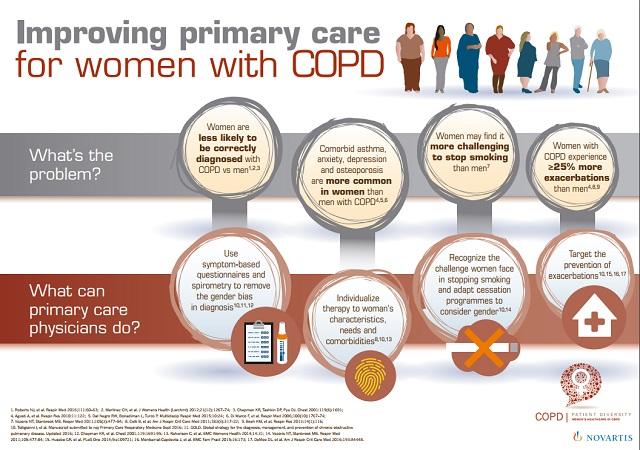Detecting COPD in women and indigent communities needed before it gets worse
Chronic obstructive pulmonary disease (COPD) is considered a "common, preventable and treatable disease" by the Philippine College of Chest Physicians (PCCP).
Despite this, the disease is largely undiagnosed and cited as the seventh leading cause of death in the Philippines by the Department of Health (DOH) in 2013.
Various studies have also indicated that women are less likely to be diagnosed with COPD and experience at least 25 percent more exacerbations than men with COPD.
Women are less likely to be correctly diagnosed with COPD compared to men and present co-morbid symptoms more often. pic.twitter.com/UvoJ1iPoZ4
— Rie Takumi (@rie_takumi) November 22, 2016
This unique situation, Novartis Healthcare Philippines President and Managing Director Cheryl Maley said Tuesday, presented a need to focus on detecting COPD in women.
“This is a huge burden to society but also very much the patients and their families. But if we can start a conversation that raises awareness, that helps to get patients diagnosed, and particularly draws attention to the fact that women may go undiagnosed for longer, we can uncover some of that reason and hopefully we can change the impact and have a very different outcome in patient journey for men and for women,” Maley said.
Gender bias and the prevalence of smoking are some of the known reasons why more women go undiagnosed than men.
“Physicians are biased against the diagnosis of COPD in women because COPD is thought to be more prevalent among men than women. This is due to the higher smoking rates. I am guilty of that,” Dr. Tim Trinidad, PCCP Council on Diagnostics and Therapeutics chairman, explained.
While mortality rates are equal among men and women, current evidence states that women are more likely to develop co-morbid asthma, anxiety, depression, and osteoporosis than men.

“What has been shown is that for women with COPD, they do have a higher rate of co-morbidities such as asthma and anxiety, which could be your correlation on why it is more difficult perhaps to correctly diagnose (women),” Maley said.
The way patients present their symptoms may also contribute to the late detection of COPD in women.
“They may often talk about allergies or symptoms that they had earlier in their life whereas men are much more direct and succinct, and talk about their breathlessness straight up, which may lead to ultimately greater clarification on their diagnosis,” Maley said.
Apart from women, workers in conditions where they regularly inhale smoke and persons who use firewood for cooking are also more likely to contract COPD without their knowledge as they frequently do not have the means to diagnose their condition.
Farmers and persons who use firewood for cooking comprise a large portion of COPD patients in the provinces; most don't know they have COPD pic.twitter.com/zcBIvkiysH
— Rie Takumi (@rie_takumi) November 22, 2016
“They were not aware that they had COPD,” Trinidad said. “Likewise, if you try to look at the prevalence of COPD in never smokers, you can see it’s 13 percent… The occupational dust exposure of our farmers and the use of firewood is wreaking havoc on the lungs of our patients in rural areas.”
The lack of access to spirometry machines, a device used to evaluate a patient's lung capacity, and qualified health physicians also hinder diagnosis of COPD.
"When we speak of resources, it’s not just about the equipment or the spirometry itself, but lack of qualified or trained personnel capable of producing quality spirometry and interpret it based on standardized recommendations," PCCP Diagnostics and Therapeutics council chair Roland Panaligan said.
While smartphone-based spirometry kits will soon be available to the public for self-diagnosis, Panaligan said it was no substitute for standard spirometry tests available in pulmonary institutions.
They can, however, increase COPD awareness, “increase case detection,” and open spirometry as a basic test both patients and physicians can easily request.
“Once it becomes available, it would solidify objective claims that spirometry is a basic test, that it can be requested especially if you have high index of suspicion, if you’re indeed a patient with COPD,” Panaligan said.
Cause of death
The World Health Organization (WHO) predicts that COPD will be the third leading cause of death worldwide by 2030.
COPD was the leading cause of death in 2002 and was attributed the deaths of three million worldwide in 2005.
While there are no nationwide studies on the prevalence of COPD in the country, a 2004 and 2006 study revealed that two out of 10 persons in Metro Manila and Nueva Ecija aged 40 and above had COPD while eight out of 10 persons tested in these areas did not know that they had this condition.
PCCP Board Member Dr. Janeth Samson said the PCCP's National Strategy for COPD in 2017 will focus on educating “family physicians in the whole Philippines" and "the lay" to drive these numbers down and correctly diagnose those already suffering from the disease.
Panaligan added that the PCCP’s national strategy will expand the number of spirometry caravans it has carried out since September 2015 by partnering with more pharmaceutical companies and local health organizations.
“More or less, we have screened about 600 to 700 patients already, and we do intend, more or less, to probably screen at least 5,000 patients nationwide,” Panaligan said.
Each spirometry session can last for 30 to 40 minutes depending on the status of the patient's lungs.
Trinidad said the PCCP will also begin a five-year study which will try to profile Filipino COPD patients and create a unique program suited to address the burden of the disease in the country.
While COPD is a permanent disease, afflicted patients can take steps to reduce their symptoms such as taking prescribed medicine and regular flu shots to counteract their weakened immune system.
Some non-pharmacologic treatments include smoking cessation, use of protective devices to lessen smoke exposure, and increased physical activity. —KG, GMA News



